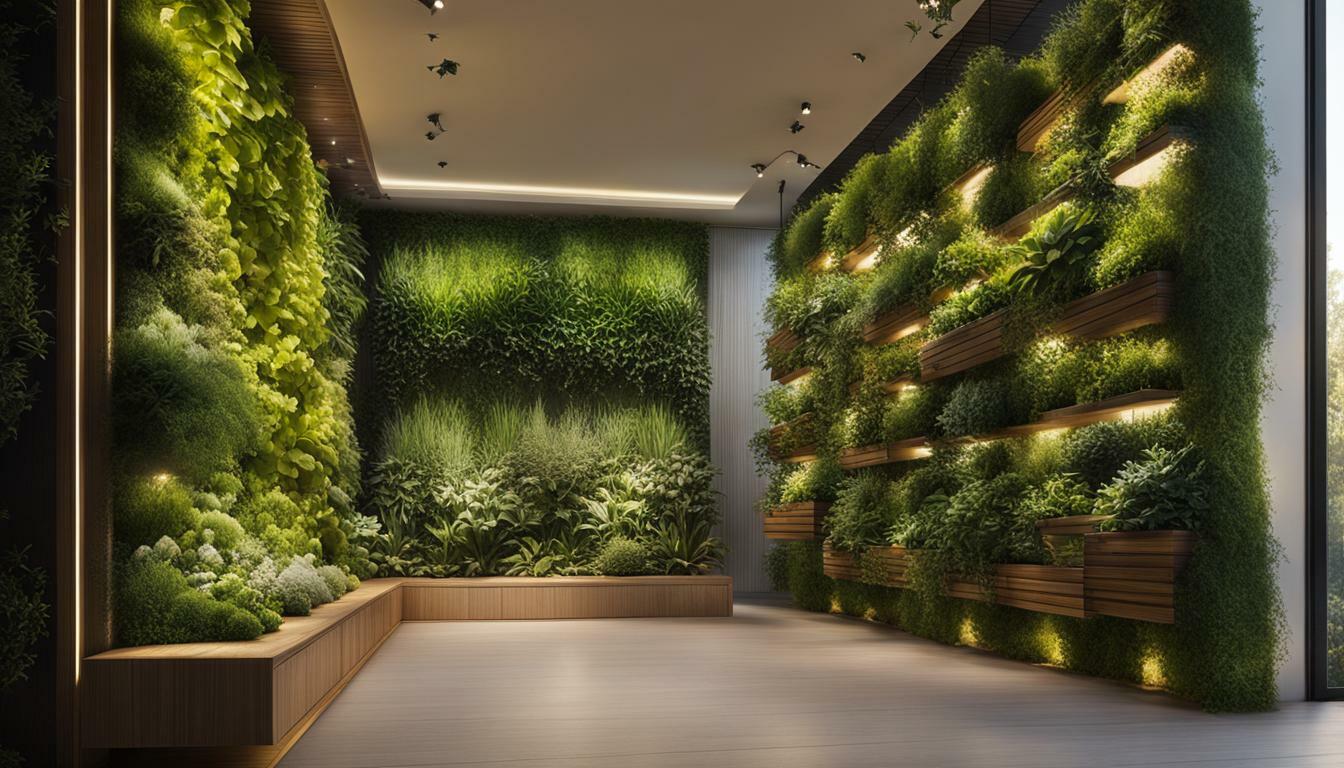Vertical gardening is a popular and innovative way to maximize space and grow a variety of plants in a limited area. It allows you to create a stunning garden that not only adds beauty to your surroundings but also offers a multitude of benefits. With vertical gardening, you can grow plants vertically, utilizing walls, fences, and structures to create a lush and thriving garden.
Key Takeaways:
- Growing plants vertically allows you to grow more plants in less space, making it especially beneficial for growing vegetables.
- Vertical gardening provides opportunities to utilize areas where you otherwise wouldn’t be able to grow anything.
- Vertical gardening saves space, improves air circulation, and makes maintenance and harvest easier.
- There are various techniques and structures for vertical gardening, such as trellises, wall gardens, tower gardens, and tiered planters.
- Choosing the right plants and techniques is essential for successful vertical gardening.
- With DIY projects and creative ideas, you can customize your vertical garden to suit your preferences and needs.
- Proper watering, plant selection, and regular maintenance are crucial for successful vertical gardening.
- Addressing common vertical gardening issues, such as pest control and soil health, is essential for maintaining a thriving garden.
- Vertical gardening offers a wide range of possibilities for design, creativity, and plant selection.
- By following expert tips and guides, you can discover the endless potential of vertical gardening and create a beautiful and thriving garden.
Benefits of Growing Plants Vertically
There are numerous benefits to growing plants vertically, including maximizing your garden space and increasing your plant yield. By utilizing vertical gardening techniques, you can grow more plants in less space, making it especially beneficial for those with limited gardening areas.
One of the main advantages of vertical gardening is that it allows you to make use of areas where you wouldn’t be able to grow anything otherwise. You can grow plants on walls, fences, balconies, or even create hanging gardens, providing exponentially more room to grow.
Additionally, growing plants vertically can improve air circulation, reduce the risk of rot, pests, and diseases, and make harvesting easier. When plants are allowed to sprawl on the ground, fruits and vegetables can get hidden under leaves, making them harder to find and harvest. However, when plants are grown vertically, the fruit hangs down from the vine, making it more accessible and visible.
“Vertical gardening isn’t just about saving space, though that’s a huge bonus. It’s also easier on your back, improves air circulation, and can result in healthier growth.” – Source
Types of Vertical Structures & Supports
When it comes to growing plants vertically, there are various types of structures and supports you can use. Trellises, fences, arches, and pergolas are popular choices for climbing plants, while vertical container gardens, such as stacked planters, wall pockets, and hanging baskets, offer unique ways to utilize vertical spaces.
The type of support you choose should be based on the characteristics of the plants you want to grow. For example, trellises work well for vining plants, while sturdier structures like arches or pergolas are suitable for grapevines or fruit trees. Additionally, vertical structures and supports can be made from a variety of materials, including wood, metal, or even upcycled materials.
When deciding on the type of vertical structure or support to use, consider your garden’s sun exposure, wind conditions, and the weight of the plants once they grow. Ensuring the structure is well-anchored and can accommodate the plant’s weight is crucial for successful vertical gardening.
Techniques Used for Growing Vertically
There are several techniques you can utilize for growing plants vertically. Trellising is a common technique used for vining or branching plants, where plants are trained to grow upward on a support structure. Caging is another popular method that involves encircling a plant with a garden cage to keep it growing vertically. Staking provides additional support to non-vining plants, preventing them from flopping over as they grow larger. Training involves guiding the vines or stems of plants to grow vertically and attaching them to the support structure when necessary. Vertical containers, such as stacked planters or wall pockets, are also commonly used for growing plants vertically in limited spaces.
By understanding and utilizing these techniques, you can effectively grow a wide variety of plants vertically, maximizing your garden space and improving plant health.
| Technique | Description |
|---|---|
| Trellising | Technique used for growing vining or branching plants vertically using various types of support structures, such as arbors, pergolas, or obelisks. |
| Caging | Encircling a plant with a garden cage to keep it growing vertically. Commonly used for vining or branching plants that can stay confined inside the cage structure. |
| Staking | Providing support to non-vining plants by using stakes to prevent them from flopping over as they grow larger. |
| Training | Guiding the vines or stems of plants to grow vertically and attaching them to the support structure when necessary. Particularly important for plants that don’t naturally grab onto the structure on their own. |
| Vertical Containers | Growing plants vertically in various types of containers, such as stacked planters, wall pockets, or hanging baskets. |
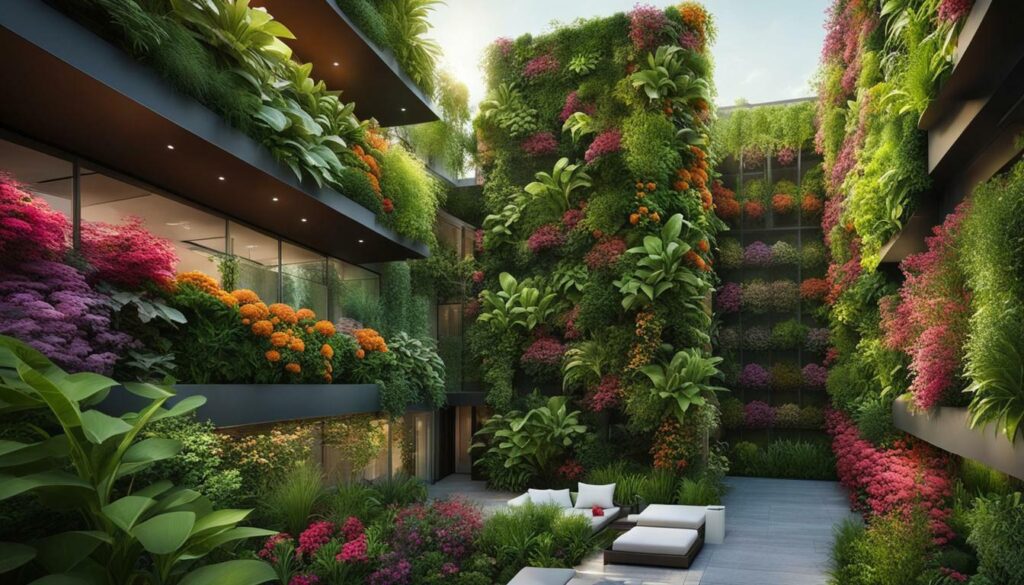
Vertical gardening offers a multitude of benefits, allowing you to maximize your garden space, increase your plant yield, and improve the health of your plants. By choosing the right techniques, structures, and supports, you can create a visually appealing and productive vertical garden that suits your space and plant preferences. Whether you’re growing vining vegetables, climbing flowers, or leafy greens, vertical gardening opens up a whole new world of possibilities for creating a lush and thriving garden.
Different Ways to Grow Vertical
Vertical gardening offers a wide range of creative possibilities, from trellises and wall gardens to tower gardens and tiered planters. With the advent of modern vertical gardening systems, you can grow plants in ways that were once unimaginable. Gone are the days when staking plants or using plain trellises were the only options. Now, you can explore a multitude of exciting and unconventional methods to cultivate a thriving vertical garden.
One popular way to grow vertically is by utilizing climbing plants. These plants can be trained to grow in various cool ways, providing height, drama, privacy, and even architectural elements to your garden. You can grow them on walls, fences, or structures such as arbors, pergolas, and obelisks.
Another innovative approach is the use of vertical container gardens. This technique allows you to utilize spaces that were previously unutilized. You can grow plants on virtually any vertical surface, including walls, balconies, and hanging from porch ceilings. Tower gardens, tiered or trellised planters, and self-standing wall gardens are just a few examples of the exciting possibilities for vertical container gardening.
Indoor vertical gardening is also gaining popularity as it allows you to bring the beauty of plants into your living space. You can create stunning living walls or utilize vertical shelves to display your favorite indoor plants, adding a touch of natural beauty to your home.
When it comes to techniques for growing vertically, there are several options to consider. Trellising is a common technique used for vining or branching plants. It involves providing vertical support, such as arbors, pergolas, or obelisks, to allow plants to grow upward. Caging is another popular technique, where plants are enclosed within a garden cage to encourage vertical growth. Staking is a common practice for non-vining plants, providing extra support to prevent them from flopping over as they grow. Training involves guiding vining plants along their support structure, while vertical containers allow you to create vertical gardens in any type of container.
When it comes to vertical structures and supports, the options are plentiful. You can choose from trellises, tripods, arches, pergolas, gazebos, wire cages, netting, bamboo poles, and more. Select a structure that suits the characteristics of your plants and matches the aesthetic of your garden. The possibilities are endless, and you can even get creative by repurposing materials or building your own supports.
| Type of Structure | Examples |
|---|---|
| Trellises | Arbors, pergolas, obelisks |
| Vertical Container Gardens | Tower gardens, hanging baskets, wall pockets, living walls, stacked planters |
| Indoor Vertical Gardens | Living walls, vertical shelves |
| Other Vertical Supports | Wire cages, netting, bamboo poles |
With such a wide range of options available, you can choose the structures and supports that best suit your gardening needs and preferences. Whether you prefer a traditional trellis or want to try something more unique, there are endless opportunities for growing plants vertically.
So, go ahead and explore the world of vertical gardening. Let your creativity flourish as you discover new and exciting ways to grow plants vertically. Whether you’re limited on space or just want to add a touch of beauty and uniqueness to your garden, vertical gardening is the perfect solution.
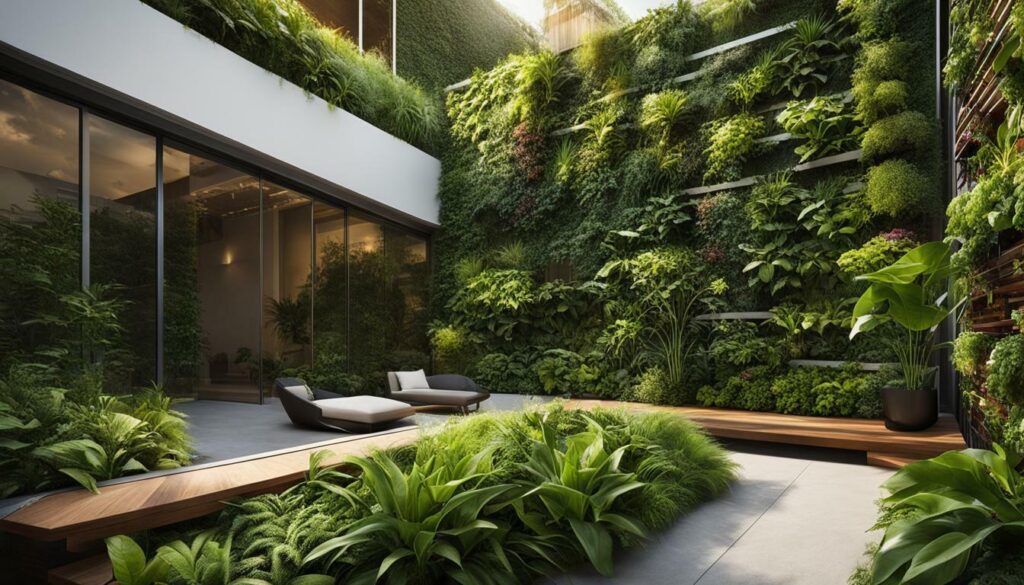
Vertical gardening offers a wide range of creative possibilities, from trellises and wall gardens to tower gardens and tiered planters.
Techniques Used for Growing Vertically
There are several techniques that can be used to grow plants vertically, including trellising, caging, staking, training, and utilizing vertical containers. Each technique offers its own unique benefits and is suitable for different types of plants.
Trellising: Trellising is a popular technique for growing vining or branching plants vertically. It involves using various types of vertical supports, such as arbors, pergolas, and obelisks, to provide structure and allow the plants to climb and grow upright.
Caging: Caging is a technique where plants are enclosed in a garden cage to keep them growing vertically. This method works well for vining or branching plants that are small enough to stay confined within the cage structure.
Staking: Staking is a common practice in vertical gardening. It involves providing support and stability to plants by inserting stakes into the ground and tying the plants to the stakes as they grow. Staking is often used for non-vining plants and helps prevent them from flopping over.
Training: Training is necessary for most vining plants to grow vertically. It involves guiding the vines or stems to grow in the desired direction and attaching them to their support structure when necessary. Training is particularly important for plants that do not naturally attach themselves to supports.
Vertical Containers: Vertical container gardening is a versatile technique that allows plants to be grown in any type of container. Stacked planters, wall pockets, hanging baskets, and tower gardens are examples of vertical container gardening. This technique is suitable for both vining and non-vining plants and offers flexibility in terms of placement and design.
By employing these techniques, gardeners can maximize their growing space, improve plant health, and create visually appealing vertical gardens.
| Technique | Plants Suitable |
|---|---|
| Trellising | Vining or branching plants |
| Caging | Vining or branching plants |
| Staking | Non-vining plants |
| Training | Vining plants |
| Vertical Containers | Both vining and non-vining plants |
“Vertical gardening is a popular trend that allows gardeners to maximize their growing space and improve plant health. By using techniques such as trellising, caging, staking, training, and utilizing vertical containers, gardeners can create beautiful and productive vertical gardens. These techniques offer flexibility and creativity in designing unique and space-saving gardens.”
With these techniques, gardeners can explore the possibilities of vertical gardening and enjoy the benefits of growing plants in a compact and visually appealing manner. Whether it’s trellising vining plants, caging tomatoes, staking tall flowers, training climbing vegetables, or utilizing vertical containers for a variety of plants, vertical gardening offers endless opportunities for creativity and productivity.
So, if you’re looking to make the most of your garden space and add a touch of vertical beauty to your outdoor oasis, consider incorporating these techniques into your gardening repertoire. Happy vertical gardening!
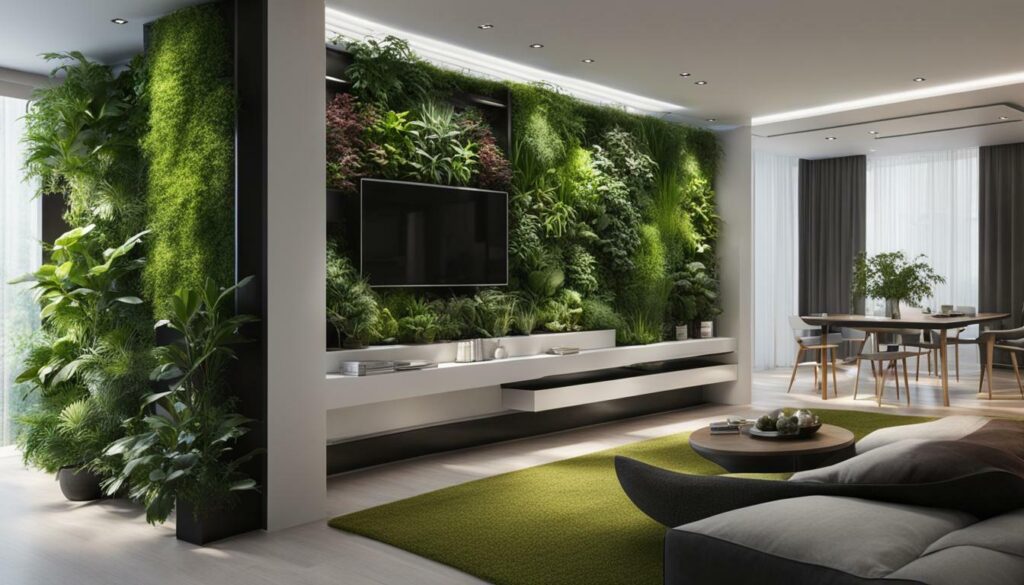
Types of Vertical Structures & Supports
There is a wide variety of vertical structures and supports available for growing climbing plants, including trellises, arches, pergolas, and vertical container gardens. These structures not only provide support for the plants but also add aesthetic appeal to your garden. Here are some of the most popular types:
- Trellises: Trellises are vertical structures made of wood, metal, or plastic that provide support for climbing plants. They can be freestanding or attached to a wall or fence. Trellises come in various shapes and sizes, such as latticework or grid patterns, allowing plants to weave through and climb.
- Arches: Arches are curved structures that create a beautiful entrance or focal point in the garden. They are typically made of metal or wood and can be used to support climbing plants like roses or vines.
- Pergolas: Pergolas are larger structures that consist of vertical posts and crossbeams. They provide a shaded area in the garden and can support climbing plants like grapes or wisteria. Pergolas can be freestanding or attached to a wall.
- Vertical Container Gardens: Vertical container gardens are a great option for small spaces or areas with limited soil. They are made up of stacked planters, wall pockets, or hanging containers, allowing you to grow plants vertically. These gardens can be easily customized and are perfect for herbs, flowers, or trailing vines.
Each type of vertical structure or support has its own unique design and benefits. Consider the size of your garden, the growth habit of your plants, and your personal style when choosing the right structure for your vertical garden.
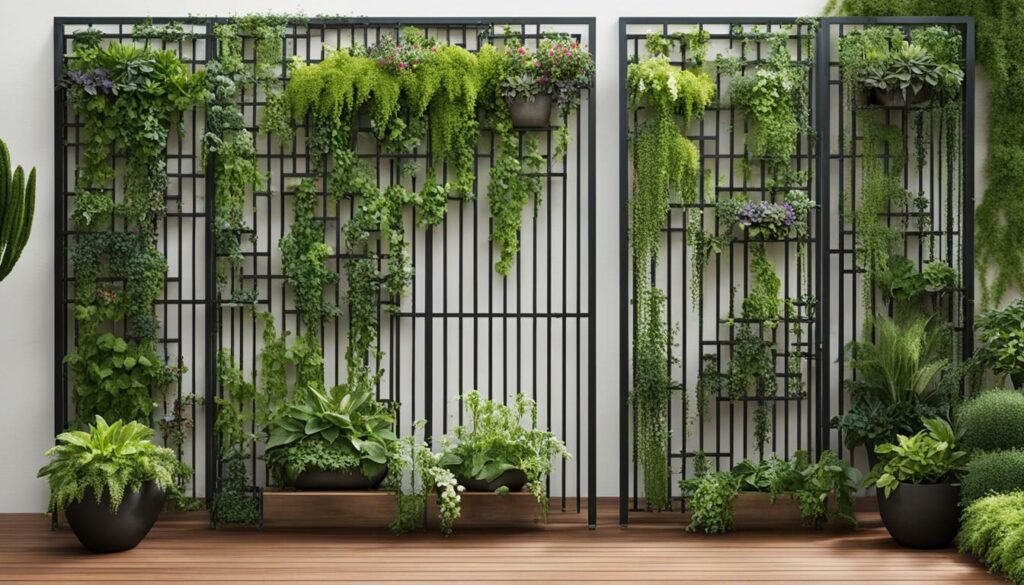
When using a trellis, arch, pergola, or vertical container garden, make sure to properly secure them to the ground or wall to provide stability and prevent them from tipping over or collapsing. Additionally, consider the weight and size of the plants you plan to grow and ensure the structure can support their growth.
Example of a Complete Table
| Vertical Structure | Materials | Recommended Plants |
|---|---|---|
| Trellises | Wood, metal, or plastic | Climbing roses, clematis, beans |
| Arches | Metal or wood | Vines, wisteria, climbing roses |
| Pergolas | Wood or metal | Grapes, wisteria, climbing roses |
| Vertical Container Gardens | Stacked planters, wall pockets, hanging containers | Herbs, flowers, trailing vines |
Choose the type of vertical structure or support that best suits your garden space and the plants you want to grow. Get creative and have fun experimenting with different designs to create a stunning vertical garden that adds beauty and functionality to your outdoor space.
Vertical Growing Design Tips
Designing a vertical garden requires careful planning and consideration, from choosing the right location to ensuring proper support and watering. It’s an exciting way to maximize your gardening space and create a stunning display of plants. Here are some tips to help you design your vertical garden:
1. Assess the Location
Start by evaluating the location where you want to create your vertical garden. Consider factors such as sunlight exposure, wind conditions, and available space. Most vegetables and fruits require at least 6 to 8 hours of direct sunlight, so choose a spot that receives adequate sunlight throughout the day. Additionally, make sure the structure you choose for your vertical garden is securely anchored to withstand strong winds.
2. Select the Right Support Structures
There are various support structures available for vertical gardening, such as trellises, arches, pergolas, and wire cages. Consider the size and weight of your plants when selecting the support structure. Smaller, lightweight plants can thrive on trellises or wire cages, while larger plants may require sturdier structures like pergolas or arches. Choose structures that complement the overall aesthetic of your garden.
3. Choose Suitable Plants
When selecting plants for your vertical garden, opt for varieties that are well-suited to vertical growing. Vining plants like pole beans, climbing peas, and tomatoes are ideal choices as they naturally grow upward. Additionally, consider the size of the plants and their growth habits to ensure they will fit within the available space and support structures.
4. Provide Proper Support and Training
Proper support and training are essential for the successful growth of vertical plants. Use ties, clips, or twine to secure the plants to the support structures and guide their growth upwards. Regularly check and adjust the supports as the plants grow to prevent them from becoming tangled or overwhelmed. Pruning may also be necessary to maintain the desired shape and size of the plants.
By following these design tips, you can create a stunning and productive vertical garden that maximizes your space and adds beauty to your outdoor area.
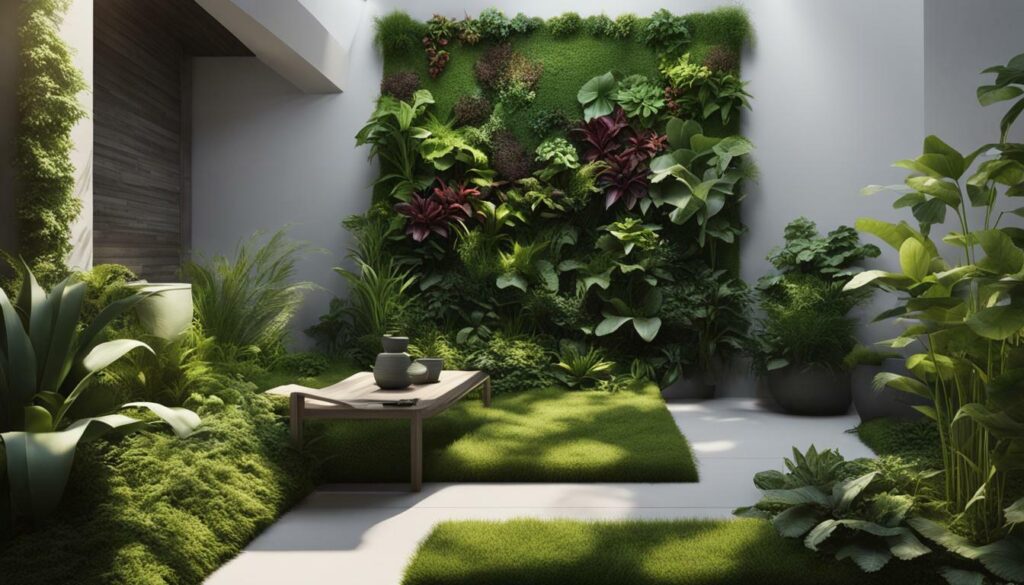
| Vertical Garden Design Tips | Benefits |
|---|---|
| Assess the Location | Maximize sunlight exposure and protect from strong winds |
| Select the Right Support Structures | Choose suitable structures based on plant size and aesthetic |
| Choose Suitable Plants | Select vining plants that thrive in vertical growing |
| Provide Proper Support and Training | Secure plants to support structures and guide growth |
With careful planning and attention to detail, your vertical garden can become a beautiful and productive oasis in your outdoor space.
Best Plants for Vertical Gardening
There is a wide range of plants that thrive in vertical gardens, including vining plants, climbing vegetables, and those that can be easily trained to grow vertically. These plants not only add beauty and interest to your garden but also maximize the use of space and increase your harvest. Here are some of the best plants to consider for your vertical garden:
Vining Plants
Vining plants are natural climbers and are perfect for vertical gardens. They have long, flexible stems that can be trained to grow up trellises, fences, or other vertical structures. Some popular vining plants for vertical gardening include:
- Grapevines: These plants produce delicious grapes and can be trained to grow along wires or a trellis.
- Passionfruit: This tropical fruit plant has beautiful flowers and tasty fruits that grow along its vines.
- Climbing Roses: These fragrant flowers can be trained to grow up a trellis or an arch for a stunning vertical display.
- Clematis: These colorful, bell-shaped flowers are known for their climbing abilities and can add a touch of elegance to your vertical garden.
These vining plants not only provide visual interest but also offer delicious fruits or beautiful flowers for you to enjoy.
Climbing Vegetables
Climbing vegetables are another great option for vertical gardening. They can be grown on trellises or other vertical supports, saving space in your garden and making harvesting easier. Some popular climbing vegetables for vertical gardens include:
- Pole Beans: These beans have long vines that can be grown on trellises or bamboo poles.
- Cucumbers: These refreshing vegetables love to climb and can be trained to grow up trellises or fences.
- Squash: Some varieties of squash, like zucchini and winter squash, can be trained to grow vertically with the help of support structures.
- Tomatoes: Indeterminate tomato varieties can be trained to grow vertically, providing support for the vines and making harvesting easier.
These climbing vegetables not only save space but also offer a bountiful harvest of fresh, homegrown produce.
Plants That Can be Easily Trained
In addition to vining plants and climbing vegetables, there are many other plants that can be easily trained to grow vertically. These plants have flexible stems that can be guided to climb up trellises, fences, or other structures. Some popular options include:
- Herbs: Many herbs, such as rosemary, thyme, and oregano, have trailing or climbing habits and can be trained to grow vertically.
- Ornamental Grasses: Some ornamental grasses, like feather reed grass or fountain grass, can be trained to grow upright, adding texture and movement to your vertical garden.
- Annual Vines: Plants like morning glories, sweet peas, or black-eyed Susans are fast-growing annual vines that can add a burst of color to your vertical garden.
- Indoor Plants: Certain houseplants, like pothos or philodendron, can be trained to grow vertically by attaching them to a moss pole or trellis.
These plants offer versatility and can be used to create a beautiful and unique vertical garden.
By choosing the right plants for your vertical garden, you can create a lush and productive space that maximizes your growing area. Whether you opt for vining plants, climbing vegetables, or easily trainable varieties, your vertical garden is sure to be a stunning and fruitful addition to your outdoor space.
| Vining Plants | Climbing Vegetables | Plants That Can be Easily Trained |
|---|---|---|
| Grapevines | Pole Beans | Herbs |
| Passionfruit | Cucumbers | Ornamental Grasses |
| Climbing Roses | Squash | Annual Vines |
| Clematis | Tomatoes | Indoor Plants |
DIY Vertical Gardening Ideas
Get creative with these DIY vertical gardening ideas, including creating a living wall, a pallet garden, a bean teepee, or a vertical arch. Vertical gardening is a great way to maximize your growing space and add a unique touch to your garden. Whether you have limited space or simply want to make a statement, these ideas will inspire you to think outside the box.
Living Wall
A living wall is a vertical garden that can be created using a variety of materials such as wooden pallets, metal frames, or even PVC pipes. It involves planting a wide range of plants directly into the structure, creating a stunning living piece of art. You can choose to grow herbs, flowers, or even small vegetables, depending on your preference. A living wall not only adds beauty to your space but also enhances air quality and provides insulation.
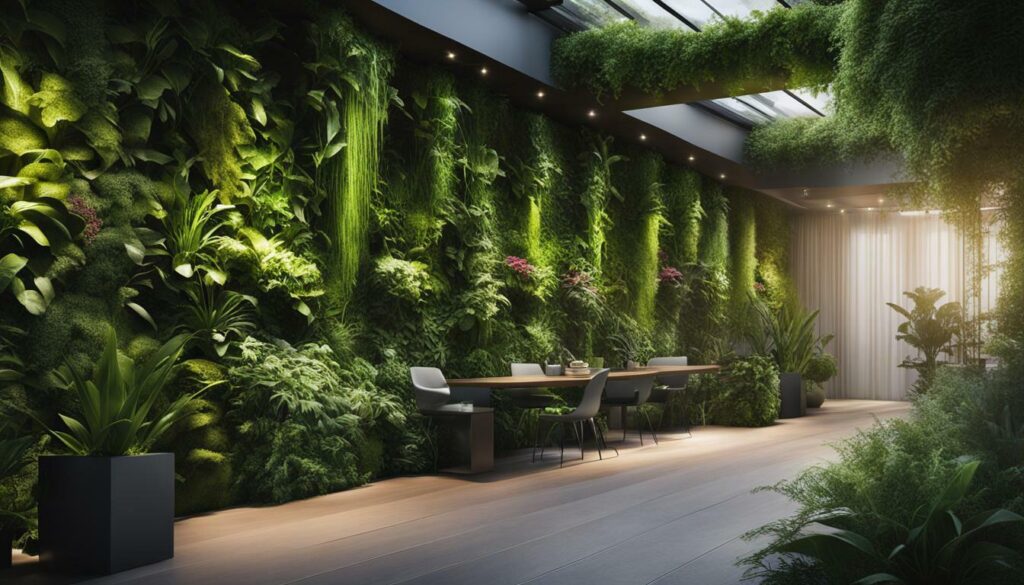
Pallet Garden
A pallet garden is an affordable and creative way to create a vertical garden. You can easily repurpose a wooden pallet by attaching small pots or containers to the slats, filling them with soil, and planting your favorite herbs, flowers, or vegetables. You can hang the pallet garden against a wall or lean it against a fence for a rustic and charming look. This DIY project is perfect for small spaces and can be customized to suit your style and needs.
Bean Teepee
A bean teepee is a fun and functional way to grow climbing vegetables such as beans or peas. Simply gather long branches or bamboo poles and tie them together at the top to form a teepee shape. Plant the bean or pea seeds at the base of each pole and watch as they grow up and form a cozy, shaded space inside the teepee. This DIY project is great for kids and adds a playful element to your garden.
Vertical Arch
A vertical arch is an elegant and eye-catching addition to any garden. You can create an arch using metal or wooden stakes and attach wire mesh or lattice panels to form a framework for climbing plants. Choose flowering vines or ivy to add a touch of romance and beauty to your outdoor space. A vertical arch can serve as a stunning focal point or create a natural entrance to your garden.
| DIY Vertical Gardening Idea | Materials Needed | Benefits |
|---|---|---|
| Living Wall | Wooden pallets, metal frames, PVC pipes | – Adds beauty to your space – Enhances air quality – Provides insulation |
| Pallet Garden | Wooden pallet, small pots or containers | – Affordable and customizable – Perfect for small spaces |
| Bean Teepee | Branches or bamboo poles, twine | – Fun and functional – Provides a shaded space – Great for climbing vegetables |
| Vertical Arch | Metal or wooden stakes, wire mesh or lattice panels | – Elegant and eye-catching – Creates natural entrance – Perfect for climbing plants |
These DIY vertical gardening ideas offer endless possibilities for adding beauty and functionality to your garden. Whether you choose to create a living wall, a pallet garden, a bean teepee, or a vertical arch, you’ll enjoy the benefits of vertical gardening, such as maximizing your growing space and adding visual interest to your outdoor oasis.
Tips for Successful Vertical Gardening
Follow these tips for successful vertical gardening, including proper watering techniques, selecting the right plants, and maintaining your vertical garden.
1. Proper watering techniques: When it comes to vertical gardening, proper watering is crucial. Watering frequency and amount will vary depending on the specific plants you are growing. It’s important to monitor the moisture levels of both the soil and the plants themselves. Consider using a drip irrigation system or self-watering containers to ensure consistent moisture.
2. Selecting the right plants: Not all plants are suitable for vertical gardening. Choose plants that have a natural inclination to grow vertically, such as climbers, vining plants, and those with long stems. Some popular choices include tomatoes, beans, cucumbers, and herbs like mint and thyme. Consider the amount of sun exposure and space available in your vertical garden when selecting plants.
3. Maintaining your vertical garden: Regular maintenance is essential for the health and productivity of your vertical garden. Prune and trim plants as needed to maintain their shape and prevent overcrowding. Keep an eye out for pests and diseases, and take appropriate measures to control them. Fertilize your plants regularly to ensure they receive the necessary nutrients for optimal growth.
| Proper Watering Techniques | Selecting the Right Plants | Maintaining Your Vertical Garden |
|---|---|---|
| Monitor soil and plant moisture levels | Choose plants with natural inclination to grow vertically | Prune and trim plants as needed |
| Consider drip irrigation or self-watering containers | Take sun exposure and space availability into account | Monitor and control pests and diseases |
“Proper watering techniques, selecting the right plants, and maintaining your vertical garden are key factors for successful vertical gardening.”
- Water regularly and consistently
- Choose plants suitable for vertical growth
- Regularly prune and trim plants
- Monitor for pests and diseases
- Fertilize plants for optimal growth
By following these tips, you can ensure a successful vertical garden that thrives and provides you with an abundance of fresh produce or beautiful flowers. Remember to adjust your watering and maintenance routine as needed and enjoy the benefits of vertical gardening.
Summary:
Successful vertical gardening relies on proper watering techniques, selecting the right plants, and maintaining your vertical garden. Monitor moisture levels and consider using irrigation systems or self-watering containers. Choose plants that naturally grow vertically, and trim and prune them regularly. Keep an eye out for pests and diseases and fertilize your plants for optimal growth. Follow these tips to create a thriving and productive vertical garden.
Maintaining and Caring for Your Vertical Garden
Proper maintenance and care are essential for the success of your vertical garden, including regular watering, pruning, and pest control. A well-maintained vertical garden will not only thrive but also continue to add beauty to your space. Here are some key tips for maintaining and caring for your vertical garden:
- Watering: Regular watering is crucial for the health of your plants in a vertical garden. Vertical gardens tend to dry out more quickly than traditional gardens, so it’s important to monitor the moisture levels and water accordingly. Consider installing a drip irrigation system or using self-watering containers to ensure consistent and efficient watering.
- Pruning: Pruning is necessary to keep your vertical garden looking neat and tidy. Trim back any overgrown or unruly foliage to maintain the desired shape and prevent overcrowding. Pruning also promotes airflow and reduces the risk of disease and pest infestations.
- Pest Control: Regularly inspect your vertical garden for any signs of pests or diseases. Common pests that may affect vertical gardens include aphids, whiteflies, and spider mites. Identify the problem early and take appropriate measures to control and eradicate the pests, such as using organic insecticides or introducing beneficial insects.
- Soil and Fertilizer: Pay attention to the quality of the soil in your vertical garden. Ensure that it is well-draining and rich in nutrients. Regularly monitor the pH levels and amend the soil if necessary. Consider using slow-release fertilizers or organic compost to provide the necessary nutrients for healthy plant growth.
By following these maintenance and care tips, you can ensure the longevity and vibrancy of your vertical garden. Remember to regularly assess the health of your plants and make any necessary adjustments to optimize their growth.
Vertical Garden Maintenance Schedule:
| Task | Frequency |
|---|---|
| Watering | Regularly, based on plant needs and environmental conditions |
| Pruning | As needed to maintain desired shape and prevent overcrowding |
| Pest Control | Regularly monitor and take action at the first sign of pests |
| Soil and Fertilizer | Monitor soil quality and amend as necessary; fertilize routinely |
Remember, proper maintenance and care are the keys to a thriving and visually stunning vertical garden. With regular attention and a little bit of effort, your vertical garden will flourish and become a beautiful focal point in your space.

Troubleshooting Common Vertical Gardening Issues
Troubleshoot common issues that may arise in vertical gardening, including pest control, maintaining soil health, and preventing plant diseases. Vertical gardening offers many benefits, but it also comes with its own set of challenges. Here are some common issues you may encounter and how to address them:
Pest Control
Pests can be a nuisance in any garden, and vertical gardens are no exception. Common pests that may affect your vertical garden include aphids, spider mites, and caterpillars. To control pests, consider using organic methods such as introducing beneficial insects like ladybugs or lacewings, using insecticidal soaps or oils, or creating physical barriers like netting or row covers. Regular monitoring and early intervention are key to preventing pest infestations.
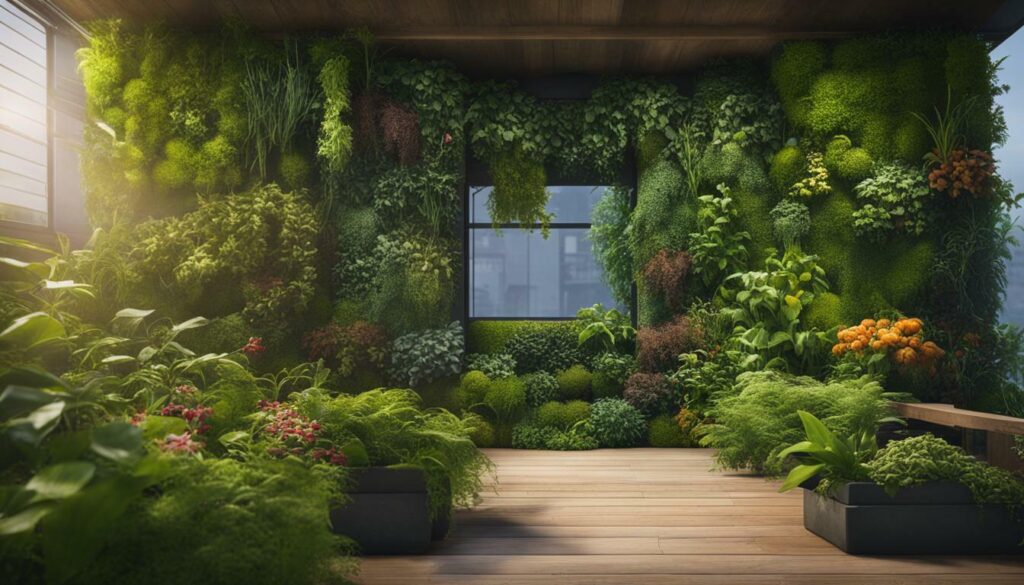
Maintaining Soil Health
Vertical gardens often utilize containers or raised beds, which require careful attention to soil health. Over time, the soil may become compacted or nutrient deficient. To maintain soil health, regularly amend your soil with organic matter such as compost or well-rotted manure to improve its structure and fertility. Consider using slow-release organic fertilizers to provide ongoing nutrients for your plants. Monitoring soil moisture levels and ensuring proper drainage will also help prevent waterlogging and root rot.
Preventing Plant Diseases
Just like in traditional gardens, plant diseases can affect vertical gardens. Common diseases in vertical gardening include powdery mildew, fungal leaf spots, and root rot. To prevent plant diseases, practice good sanitation by removing any infected plant material, avoiding overwatering, and providing adequate air circulation. Using disease-resistant plant varieties and practicing crop rotation can also help prevent the spread of diseases.
By addressing these common issues and implementing proper maintenance practices, you can ensure the success of your vertical garden. Remember to regularly monitor your plants, provide adequate support and care, and stay proactive in addressing any issues that arise. With proper troubleshooting, you’ll be able to enjoy a beautiful and thriving vertical garden.
Conclusion
Vertical gardening offers a wealth of benefits and possibilities, allowing gardeners to maximize their space and grow a variety of plants in a creative and efficient manner. Whether you have limited gardening space or simply want to add a unique touch to your garden, growing plants vertically is an excellent solution.
One of the major benefits of vertical gardening is the ability to grow more plants in less space. Vertical structures and supports, such as trellises and wall gardens, provide additional growing areas that would otherwise go unused. This is especially advantageous for growing vegetables, as it allows for increased plant yield without taking up valuable ground space.
In addition to saving space, vertical gardening also promotes healthier plants. By lifting the foliage and fruit off the ground, the risk of rot, pests, and diseases is reduced. Improved air circulation and easier access to the plants make maintenance and harvest much simpler.
There are numerous ways to grow plants vertically, from trellises and tower gardens to tiered planters and vertical containers. Each method offers its own unique benefits and can be tailored to suit your specific gardening needs and preferences.
When it comes to choosing plants for vertical gardening, vining plants and climbing vegetables are the ideal choices. These plants are naturally inclined to grow vertically and can be easily trained or supported to achieve optimal growth. However, with creative thinking and proper care, nearly any plant can be grown vertically.
To get started with vertical gardening, you can explore various DIY projects, such as creating a living wall, a pallet garden, a bean teepee, or a vertical arch. These projects offer both practical and aesthetic appeal, allowing you to personalize your vertical garden to suit your style and space.
While vertical gardening offers numerous benefits, it’s important to keep in mind some essential tips for success. Proper watering techniques, careful plant selection, and regular maintenance are key to ensuring optimal growth and productivity in your vertical garden.
By following these guidelines and troubleshooting common issues that may arise, you can maintain a thriving vertical garden that brings beauty and abundance to your space. With the potential to grow more plants, save space, and enjoy the convenience of vertical gardening, there’s no doubt that this gardening technique offers endless possibilities for every gardener.
What Are the Best Plants to Grow in a Vertical Garden for Veggies?
When planning your vertical veggie garden strategies, consider growing compact and climbing vegetables like tomatoes, cucumbers, and peppers. Leafy greens such as lettuce, spinach, and kale also thrive in vertical gardens. Herbs like basil, cilantro, and thyme are perfect for small spaces and add flavor to your meals.
FAQ
Q: What are the benefits of growing plants vertically?
A: Growing plants vertically allows you to maximize space and grow more plants in a smaller area. It also helps improve air circulation, reduces the risk of disease, and makes harvesting easier.
Q: What are some different ways to grow plants vertically?
A: There are various methods for vertical gardening, including using trellises, wall gardens, tower gardens, and tiered planters. You can also get creative with vertical container gardens and hanging baskets.
Q: What are the techniques used for growing plants vertically?
A: The techniques for vertical gardening include trellising, caging, staking, and training. Trellising is used for vining or branching plants, caging keeps plants contained, staking provides support, and training involves guiding vines or stems to grow vertically.
Q: What are some types of vertical structures and supports for climbing plants?
A: There are various types of vertical structures and supports, such as trellises, arches, pergolas, and vertical container gardens. These can be made from materials like wood, wire, or even repurposed items.
Q: Do different plants require specific growing conditions for vertical gardening?
A: Yes, different plants have different requirements. Vining plants like pole beans, climbing peas, and vining tomatoes are ideal for vertical gardening. Other vegetables like cucumbers, squash, and melons can also be trained to grow vertically. It’s important to consider the sunlight and wind exposure in your garden when selecting plants.
Q: What are some DIY ideas for vertical gardening?
A: DIY vertical gardening projects include creating a living wall, a pallet garden, a bean teepee, or a vertical arch. These projects can be customized to suit your space and preferences.
Q: What tips can you provide for successful vertical gardening?
A: Proper watering techniques, choosing the right plants for vertical gardening, and planning for support and maintenance are essential for success. It’s also important to regularly prune and control pests in your vertical garden.
Q: How do you maintain and care for a vertical garden?
A: Regular watering, pruning, and pest control are necessary for maintaining a vertical garden. It’s also important to monitor soil health and provide adequate nutrients for your plants.
Q: What are some common issues in vertical gardening and how can they be addressed?
A: Common issues in vertical gardening include pest control, soil health, and plant diseases. Proper pest management, regular soil testing and amendment, and early detection and treatment of plant diseases can help address these issues.
Q: What should be considered in the conclusion of vertical gardening?
A: Vertical gardening is a versatile and space-saving technique that offers numerous benefits. With the right techniques, plant selection, and maintenance, anyone can create a thriving vertical garden.

